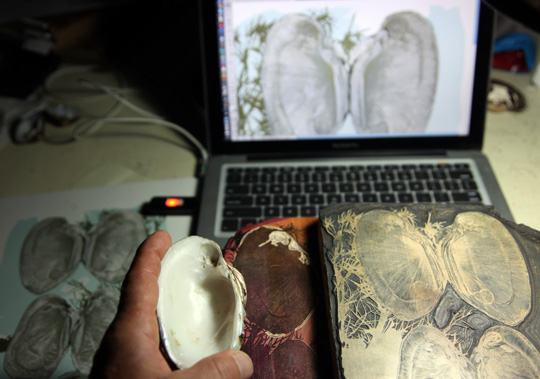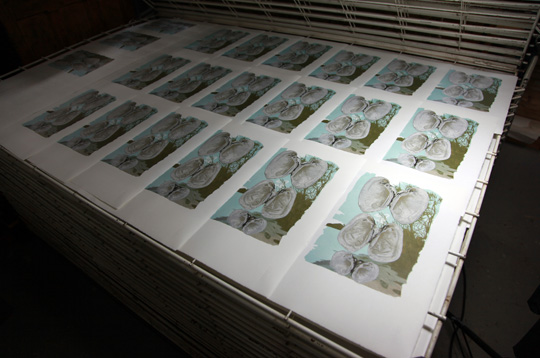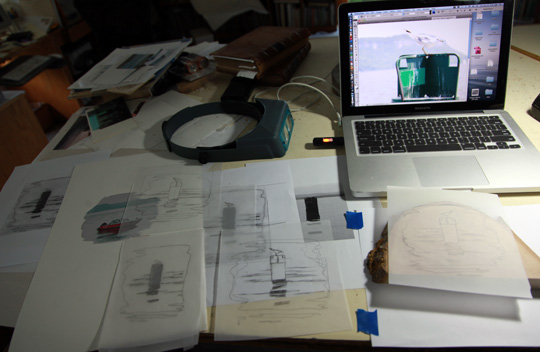 The basic orientation problem when it comes to printing in relief is, of course, image reversal–the inked impression of a surface is its mirror image. In a complex image involving multiple blocks and numerous over-printings of color, things get complicated rather quickly. One early decision that proved to be a good one was to make the mussel blocks the same orientation as the specimens themselves. This made studying the shells while engraving them much easier. As a result I had to scan images proofs as I went along, and flip them horizontally in Photoshop so they could be studied in the same orientation as the blocks (and the shells themselves) but the ability to study the actual specimen while engraving was worth the trouble. The printed image is the reversal of the animal’s true orientation, but I can live with that.
The basic orientation problem when it comes to printing in relief is, of course, image reversal–the inked impression of a surface is its mirror image. In a complex image involving multiple blocks and numerous over-printings of color, things get complicated rather quickly. One early decision that proved to be a good one was to make the mussel blocks the same orientation as the specimens themselves. This made studying the shells while engraving them much easier. As a result I had to scan images proofs as I went along, and flip them horizontally in Photoshop so they could be studied in the same orientation as the blocks (and the shells themselves) but the ability to study the actual specimen while engraving was worth the trouble. The printed image is the reversal of the animal’s true orientation, but I can live with that.
 On the afternoon of June 21 the final impression from the final block of the upstream side of the mussel image was taken, more than 5 months since work on the mussels began. Though composed, as you have seen, of more than one image, I see it as a single unit: the upstream, inside surfaces of the three pairs of mussel shells on the recto; the downstream, outside surfaces of the three on the verso; and the beautiful fractured Pyganodon grandis filling the sky over the Lac Des Pleurs. The recto, upstream image is purposely more monotone and less dramatic (by far) than the recto downstream image in order to enhance the impact of tuning the page–I am, remember, printing a book!
On the afternoon of June 21 the final impression from the final block of the upstream side of the mussel image was taken, more than 5 months since work on the mussels began. Though composed, as you have seen, of more than one image, I see it as a single unit: the upstream, inside surfaces of the three pairs of mussel shells on the recto; the downstream, outside surfaces of the three on the verso; and the beautiful fractured Pyganodon grandis filling the sky over the Lac Des Pleurs. The recto, upstream image is purposely more monotone and less dramatic (by far) than the recto downstream image in order to enhance the impact of tuning the page–I am, remember, printing a book!
 Now back to the drawing board. I will be working on the tail piece image–a gull on a buoy–while I ready the blocks for the final large image left to print:
Now back to the drawing board. I will be working on the tail piece image–a gull on a buoy–while I ready the blocks for the final large image left to print:
a dead drum drifting…